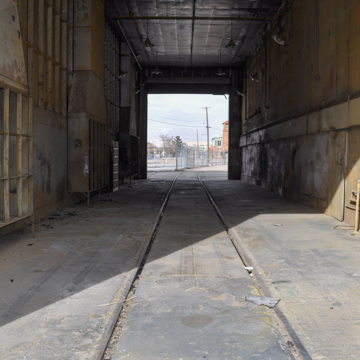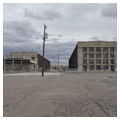The Atchison, Topeka and Santa Fe (AT&SF) Locomotive Shops are the most significant extant artifacts of the industrial age that shaped Albuquerque at the turn of the twentieth century. Abandoned since the 1970s, the complex survived through benign neglect and is now being slowly rehabilitated by the city as a historically significant site.
The twenty-one structures that make up the Locomotive Shops occupy some twenty-seven acres of ground between railroad tracks to the east and First and Second Streets to the west. Erected between 1914 and 1925, they replaced earlier wooden structures built shortly after 1880, when the AT&SF selected Albuquerque as a major depot and its principal rail yard in New Mexico. Their sober industrial purpose and form stood in contrast to the AT&SF Depot and connecting Alvarado Hotel, which were located to the north at the corner of First Street and Central Avenue. Built in 1901–1902 (demolished 1972) to designs by the architect Charles Whittelsey, the depot and hotel were the railroad’s public face, and their California Mission style architecture offered tourists a romantic image of the Southwest.
The Locomotive Shops were designed by an in-house team (Chief Architect E.A. Harrison, Chief Engineer C.F.W. Felt, and Bridge Engineer A.F. Robinson) to serve the multiple functions required for the inspection, maintenance, and rebuilding of locomotives. After they were inspected and disassembled in the machine and boiler shops, locomotive parts were distributed throughout the complex for cleaning, repair, and replacement. Overhead cranes, a depressed concrete transfer table, and a cross-axial grid of tracks (traversing north-south) moved locomotives, parts, and supplies between buildings, and delivered them to the specialized repair and maintenance facilities. These included a boiler shop, blacksmith shop, flue shop, sheet metal house, and tender repair shop. A fire station at the northwest corner of the complex housed the AT&SF Fire Department.
Constructed of concrete, steel, and glass, these utilitarian buildings were designed to span large open spaces efficiently and economically. Recalling the nineteenth-century railroad sheds from which they are descended, the structures are characterized by curtain walls of factory glass and the taut steel members of their roof trusses. At the same time, the cast-concrete classical facades fronting the machine and boiler shops suggest Greek temples and may indicate that the railroad hoped these sheds might be recognized as architectural monuments, an aspiration that recalls Peter Behrens’ AEG Turbine Factory in Berlin, Germany (1908).
The classical facades facing Second Street were also expressions of civic pride and the new social and economic order driving Albuquerque’s transformation from a Spanish-Colonial village into a modern American city in the first decades of the twentieth century. Between 1881 and the mid-twentieth century, the AT&SF employed a quarter of the city’s local work force; from 1915 until 1956, the shops serviced an average of forty steam locomotives per month.
Employment surged during World War II, but when more efficient diesel-powered engines replaced steam locomotives in 1956, the shops were repurposed as a facility for track repairs. At that time, employment dropped from 1,000 workers to fewer than 200. The complex ceased operations in the late 1970s, although the railroad maintained its ownership of the buildings until the 1990s.
Initially purchased by a private developer whose plans were never realized, the City of Albuquerque acquired the complex in 2007, with the intention of rehabilitating it as a functioning historic site. In 2012, the city contracted the Los Angeles-based firm Eric Owen Moss Architects and the developer Samitaur Constructs to redevelop the site. The proposed redevelopment will repurpose the existing structures as commercial, residential, and cultural spaces, while retaining both their historic character and existing layout. The first rehabilitated structure, the blacksmith shop, opened in 2014 as a community space. The storehouse now holds the Wheels Museum, documenting Albuquerque’s transportation history.
Only the blacksmith shop and storehouse are currently open to the public; other structures will be accessible as redevelopment continues.
References
Brooker, Kathleen Ann.“Railroad Depots in New Mexico: Southwestern Styles and the Masonry Tradition.” Master's thesis, University of New Mexico, 1981.
Dodge, William A., Maryellen Hennessy, Edgar Bolson, and Petra Morris, “Atchison, Topeka & Santa Fe Railway Locomotive Shops,” Bernalillo County, New Mexico. National Register of Historic Places Registration Form, 2014. National Park Service, U.S. Department of the Interior, Washington, D.C.
“Growth of Albuquerque is Paralleled by Santa Fe RY.” Albuquerque Progress 10, no. 5. June 1943.
Moses, Nalina. “Going the Extra Yards.” AIArchitect, August 8, 2014. Accessed September 30, 2014. http://www.aia.org/.
Myrick, David. New Mexico’s Railroads: A Historical Survey. Revised edition. Albuquerque: University of New Mexico, 1990.
Samitaur Constructs. “Albuquerque Railyards Masterplan (Adopted June 2014).” Accessed June 19, 2015. https://www.cabq.gov/.
Simmons, Marc. Albuquerque: A Narrative History. Albuquerque: University of New Mexico, 1982.
Slaney, Deborah C. Jewel of the Railroad Era: Albuquerque’s Alvarado Hotel.Albuquerque: Albuquerque Museum, 2009.
Threinen, Ellen. Historic Architecture of Albuquerque’s Central Corridor. Albuquerque, NM: Task Force of Albuquerque Center, 1977.
Wilson, Chris. “The Historic Railroad Buildings of Albuquerque: An Assessment of Significance.” Prepared for the Redevelopment Division, Planning Department, City of Albuquerque, 1986.






